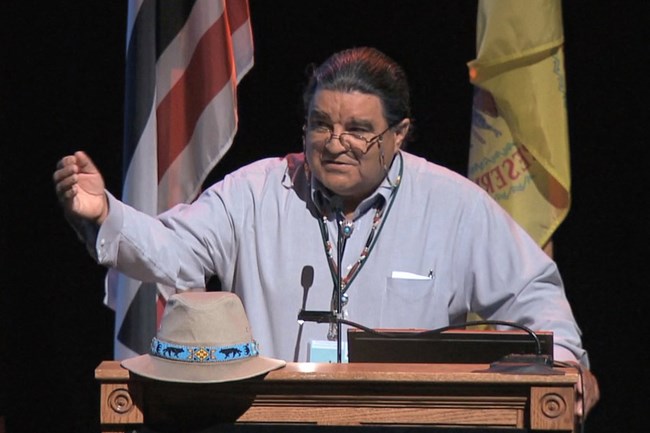
Jerry Lassos, a Gabrielino, talks about Scott O’Dell’s use of the word Ghalas-at, which is actually a Chumash word, and about his tribe’s name for San Nicolas Island. The Gabrielino Indians live on the mainland and historically lived on the southern Channel Islands. They are the tribal group most closely connected to the San Nicolas Island people, who are referred to as Nicoleños. The Chumash Indians live on the mainland and historically lived on the northern Channel Islands.
Ghalas-at is the Chumash name for San Nicolas Island. It’s possible that Scott O’Dell chose to use the Chumash word Ghalas-at for the name of Karana’s village believing that the Lone Woman was Chumash, which is not correct. Evidence suggests that the Lone Woman was Nicoleño.
We call the island Haraashngna. We don’t know what the Lone Woman and her people might have called their village or island.
-
Listen to chapter 1 entry
Learn about the Gabrielino name for San Nicolas Island.
Chapter 28
Jerry Lassos, a Gabrielino, talks about the construction of his tribe’s canoes.
The Gabrielino canoe is called a ti’at, which means “sewn-plank canoe” in our language. The ti’at is similar to the tomol, the plank canoe used by the Chumash, who lived on the northern Channel Islands and also on the mainland. In the 1800s (nineteenth century), Gabrielinos lived on the southern Channel Islands, including San Nicolas Island, and on the mainland.
The Gabrielinos and the Chumash are the only North American natives to build seagoing plank canoes. The ti’at and tomol are the most technologically complex native watercraft built in North America. All other native boats on the west coast of North America are either dugout logs or tule balsas, which are bundles of dried reeds fashioned into canoes.
Native islanders and coastal dwellers made ti’ats and tomols from redwood logs that washed ashore as driftwood. The logs were split into planks using bone and stone wedges. Stone and shell tools were used to shape the planks, which were then smoothed by sharkskin, used like sandpaper.
Holes were drilled into the planks that were then bound together with cordage (rope) made from plants. The planks and the holes were sealed with asphaltum, a naturally occurring tar-like substance. Inlaid decorations of crushed shells were often added.
Today, Gabrielino and Chumash descendants continue to practice and share their maritime culture, including making canoes.
-
Listen to chapter 28 entry
Learn about construction of Gabrielino canoes, called ti'ats.
Last updated: February 25, 2020
